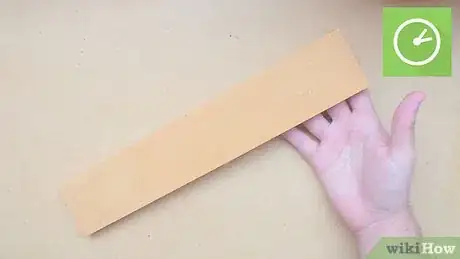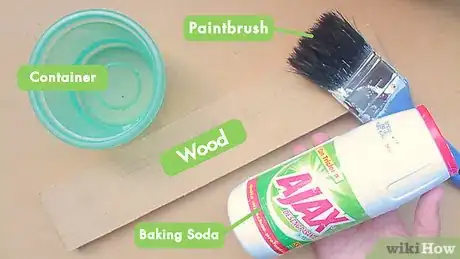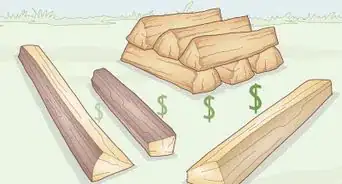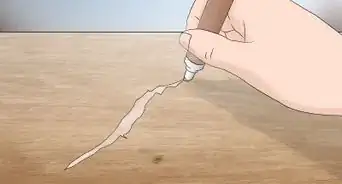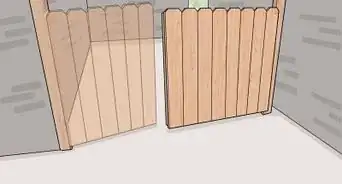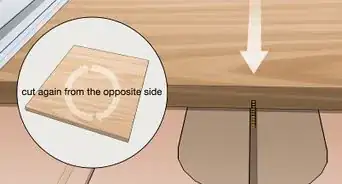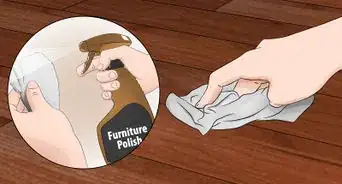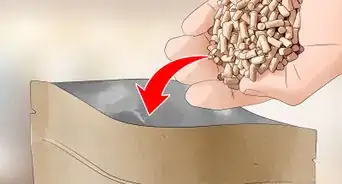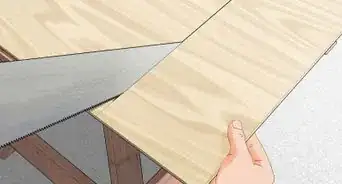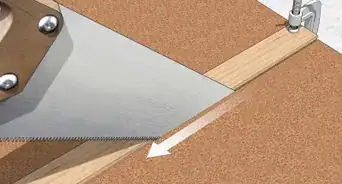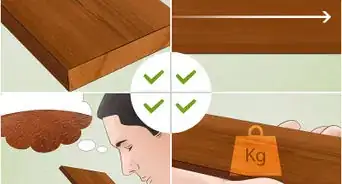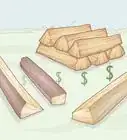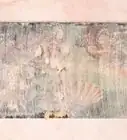This article was co-authored by wikiHow Staff. Our trained team of editors and researchers validate articles for accuracy and comprehensiveness. wikiHow's Content Management Team carefully monitors the work from our editorial staff to ensure that each article is backed by trusted research and meets our high quality standards.
There are 8 references cited in this article, which can be found at the bottom of the page.
The wikiHow Video Team also followed the article's instructions and verified that they work.
This article has been viewed 90,406 times.
Learn more...
Weathering wood, also called aging or distressing, is a process where new wood is made to look old or worn. Weathering is especially important when you need to replace a piece of wood in an old structure or if you're trying to give a new woodworking project an antique feel. Each kind of wood will react to weathering process differently, so you should do a trial run on a small piece before the main project. Then, using vinegar or baking soda and some manual techniques, you can weather your wood.
Steps
Distressing Wood with Vinegar
-
1Choose your vinegar. Using different kinds of vinegar when weathering will give the appearance of your wood a different look. White distilled vinegar will give you more of a brown color in your wood, apple cider vinegar will impart more of a bluish-gray, and balsamic vinegar will have more of a green tint.[1]
- Depending on the wood you are using, the intensity of your vinegar weathering may vary. Differences in wood composition will influence the end result.
- These kinds of vinegar are generally inexpensive and can be found at most grocery stores. You don't need a fancy brand for great results, even generic kinds of vinegar should work well for weathering.
-
2Gather your supplies. To create your weathering solution, you're going to need to dissolve some steel wool into the vinegar. After that, you'll apply that solution with a paintbrush to begin aging your wood. When it dries, you can finish it all with a coat of staining. In all, you'll need:
- A bowl (or other container)
- A paintbrush
- Coffee grounds (optional)
- Steel wool (or soap pads)
- Wood
- Wood staining (recommended; optional)
- Vinegar (distilled, apple cider, or balsamic)[2]
Advertisement -
3Dissolve your steel wool in the vinegar. In your bowl or container, pour enough vinegar to coat the entire surface of the wood you are weathering. Since vinegar is a relatively thin liquid and spreads easily, 1 - 2 cups should be enough. Then place a piece of steel wool into the solution.
- Generally, the longer you allow your vinegar and steel wool to sit, the more intense the weathering effect will be.
- You may want to use a fine steel wool, like 0000 steel wool, as this will dissolve more easily in your vinegar solution and decrease the wait time.
- At about the 15 minute mark, your steel wool will start dissolving into the solution. This will create a lighter weathering effect. Longer wait times will produce a darker result.
- Adding a second piece of steel wool to the mix can speed the process along, as there will be more steel available for the vinegar to break down.[3]
-
4Add coffee grounds to the solution for darker weathering. Used or new coffee grounds will help to bring out rich, brown tones in your weathered wood. Instant coffee, however, reacts more easily to water, and will likely have the most pronounced effect. A tablespoon of grounds in your solution should be sufficient, if you wish to darken the effect of your weathering.
- You can modify the amount of coffee used in your solution. Less coffee will result in more subtle brown tones, while more will give a more dramatic color.[4]
-
5Prepare your wood. Dirt on your wood can create a patchy effect in your weathering. Additionally, irregular and uneven parts may not weather consistently. To ensure the best results, you should at minimum clean your wood with a damp rag.
- For projects that you want to have a more finished look, you should consider sanding the wood so that it is even and smooth.
-
6Apply your weathering solution to your wood. For larger projects, you'll likely need to dip a paintbrush into the solution to apply it to your wood. When doing so, cover the wood completely and generously, but do not leave any solution puddled on it. For smaller projects, you may be able to dip the wood directly into the weathering solution.
- When dipping, you should keep your fingers out of the solution. Use a pair of pliers, tongs, or a plastic glove to prevent skin contact.
- The more coats of solution you apply, the more weathered the wood will appear. For most projects, dipping once or twice for a minute or two will be sufficient. When applying with a paintbrush, one or two coats should be enough.
- Err on the side of caution when applying your weathering solution. If you find the wood isn't weathered enough after it is dry, you can always reapply your solution.[5]
-
7Allow the wood to dry completely. As your wood dries, you may be discouraged that the appearance has not changed very much. This is common, and in most cases the character of your now weathered wood can be brought out with a coat of staining.
- Depending on the climate where you live, your wood may dry in a few hours or it might take an entire day. When the wood is completely dry to the touch, it should be dry enough to move on.
- If you're in a rush and can't wait for your wood to air dry, you can use a hair dryer to speed up this process.
- As the wood dries, you should note a slight to significant change in color and a more pronounced grain.
- If your dry wood is not as weathered as you like, you should reapply your weathering solution and allow it to dry again. Continue this process until you achieved your desired look.[6]
-
8Stain your wood, if desired. Staining your wood will add color, but it will also bring out the features of your weathering. Many kinds of lighter colored wood may not show much weathering until it is stained. Staining can be bought at most hardware stores, or in the home improvement section of most general retailers.[7]
- Staining can dramatically change the appearance of wood, and some staining might react less favorable with your weathered wood than others. You should stain a test piece of weathered wood to prevent any unpleasant surprises.
- There are many different brands of wood staining you might use. For the best results, you should follow the directions on the brand you purchased.
Create a Vintage Look with Baking Soda
-
1Collect your weathering supplies. You're going to be changing the appearance of your wood with a solution of warm water and baking soda. After the solution is mixed, you'll apply it to your wood with a paintbrush, allow it to dry, and then you can stain the wood if you desire. All things considered, for this project you'll need:
- A container (for your weathering solution)
- A paintbrush
- Baking soda
- Wood
- Wood staining (recommended; optional)[8]
-
2Prepare your wood. Dirt, dust, or irregular bits of wood can make the application of your weathering solution inconsistent. Wiping down your wood with a damp, clean rag first will help prevent this from happening. You might also want to sand the wood to give it a professional, well-finished look.
-
3Mix your solution. There is no perfect proportion for this weathering solution. A high concentration of baking soda in warm water will produce a more intense weathering effect. A good starting point, however, is 1 cup of warm water and 1 tablespoon of baking soda.[9]
- Mix your baking soda and water thoroughly before applying the solution. If the baking soda isn't equally distributed, parts of your wood could look more weathered than others.
- Baking soda has a chemical reaction with a substance in the wood known as "tannins." Wood high in tannins, like mahogany, oak, and walnut, will react more intensely with this solution.
- Generally, hardwoods have a higher tannin content than softwoods. If you notice natural yellow, red, or brown tinting in the wood, this could be a strong indication of tannins.
- Since wood with a higher tannin content reacts stronger than lower tannin wood, you may want to decrease the amount of baking soda when weathering high tannin wood.[10]
-
4Apply your solution to the wood. Take your paintbrush and dip it into your weathering solution. Use a generous coating to completely cover your wood with the solution, but do not leave excess puddling on it. Pay special attention to cracks and knots, as these can be difficult to completely coat.
- It's better to use less than more at this point in the weathering. If after the wood dries it is not weathered to the point you desire, you can add another layer of solution.
- A single coat of this solution should be enough to have a noticeable effect on your wood, though the change in woods containing few tannins may be slight.[11]
-
5Allow the wood to dry. Since you've only applied a single coat to your wood, it shouldn't take too long for it to dry. In most climates, 10 minutes should be enough for your wood to be ready for staining, though in humid regions this may take longer.
- If your wood is taking longer to dry than you'd like, you can use a hair dryer to dry it more quickly.
- Observe your wood closely at this point. If it is not as weathered as you wanted, you should apply another coat of your weathering solution and allow it to dry again.[12]
-
6Add a coat of wood staining to highlight weathering. This step is optional, though adding staining to your wood will make the weathering more distinct. Use a clean brush to apply your stain in the fashion indicated by its label until the surface of the wood is completely stained.
- Use a test piece of wood that you've already weathered to prevent unpleasant surprises. Some stains may have an unexpected effect on your weathered wood.[13]
Using Tools and Manual Techniques
-
1Scour the wood with a stiff wire brush. The weathered look is caused by wood breaking down over time, and you can simulate this wear by using a wire bristle brush on your wood. However, this process can take a great deal of time and effort before you achieve the right effect.
- The stiffer the bristles of your brush, the more it will break down the wood as you scrub. Use strong, firm pressure for the best results.
- Depending on the kind of wood you are using, this process might take a day or more of hard scrubbing before the effects are apparent.
-
2Erode the wood with rocks. Rocks, stones, and other airborne particles naturally wear wood down over time. You can do the same by adding small, irregularly shaped rocks and pebbles to the surface of your wood and scrubbing it with your wire brush or stepping on the stones to scrape the stones against wood.
- The key to this technique is trapping the stones between your brush or foot before applying pressure. As the rocks rub against or are ground into the wood, it will break down and look more weathered.
- Exercise care when trying to grind stones into your wood with your feet. You can very easily lose balance and injure yourself.
- You may be able to erode a larger area of your wood at a time by sandwiching rocks between two boards and standing on the top board.[14]
-
3Use a tool to etch the wood. This technique allows for the most intentional weathering. With a tool, like a woodworking knife, a screwdriver, or a chisel, you can add notches and small cuts to give more character to the wood. However, the cuts you make may appear unnatural. In this case:
- Use sandpaper to soften the sharp edges of your cuts to make them look more natural. Hardwoods may require a coarser grain of sandpaper for you to sand effectively.
- Use your wire bristle brush to make your tool weathering appear less intentional. Even a few passes with your brush can have a significant effect.
Warnings
- When weathering with manual techniques, small pieces of stone or wood can pose a danger to your eyes. For this reason, you should wear protective eye-wear.⧼thumbs_response⧽
Things You'll Need
Weathering with Vinegar
- A bowl (or other container)
- A paintbrush
- Coffee grounds (optional)
- Steel wool (or soap pads)
- Wood
- Wood staining (recommended; optional)
- Vinegar (distilled, apple cider, or balsamic)
Distressing Wood with Baking Soda
- A container (for your weathering solution)
- A paintbrush
- Baking soda
- Wood
- Wood staining (recommended; optional)
Adding Character with Manual Techniques
- Etching tool (i.e. a knife or chisel)
- Small rocks
- Stiff wire bristle brush
References
- ↑ http://mountainmodernlife.com/how-to-make-new-wood-look-old/
- ↑ https://www.youtube.com/watch?v=JFEnAWBPJgU
- ↑ http://www.lilblueboo.com/2014/04/how-to-antique-and-age-wood-instantly-for-a-weathered-look.html
- ↑ http://mountainmodernlife.com/how-to-make-new-wood-look-old/
- ↑ https://www.youtube.com/watch?v=JFEnAWBPJgU
- ↑ http://mountainmodernlife.com/how-to-make-new-wood-look-old/
- ↑ https://www.youtube.com/watch?v=JYH083c8dEw
- ↑ http://radmegan.com/2011/05/guest-blogger-thursday-weathered-wood-shelf.html
- ↑ https://www.youtube.com/watch?v=JYH083c8dEw
- ↑ https://www.ncsu.edu/bioresources/BioRes_07/BioRes_07_3_3767_Miklecic_SJ_Wood_Color_Change_NH3_Fuming_2762.pdf
- ↑ https://www.youtube.com/watch?v=JYH083c8dEw
- ↑ http://radmegan.com/2011/05/guest-blogger-thursday-weathered-wood-shelf.html
- ↑ https://www.youtube.com/watch?v=JYH083c8dEw
- ↑ http://www.lowes.com/creative-ideas/other-activities/how-to-distress-wood/project
- Videos provided by TheCrafsMan
About This Article
To weather wood, pour vinegar into a bowl and place a steel wool pad into the bowl. After about 15 minutes, the steel wool will start to dissolve. The darker you want the effect to be, the longer you should leave the steel wool in the vinegar. For even darker weathering, add a spoonful of coffee grounds to the solution. Use a paintbrush to apply the vinegar solution to the wood and allow it to dry completely. Stain the wood to bring out the effect of the weathered wood. Keep reading to learn how to weather wood with baking soda!


